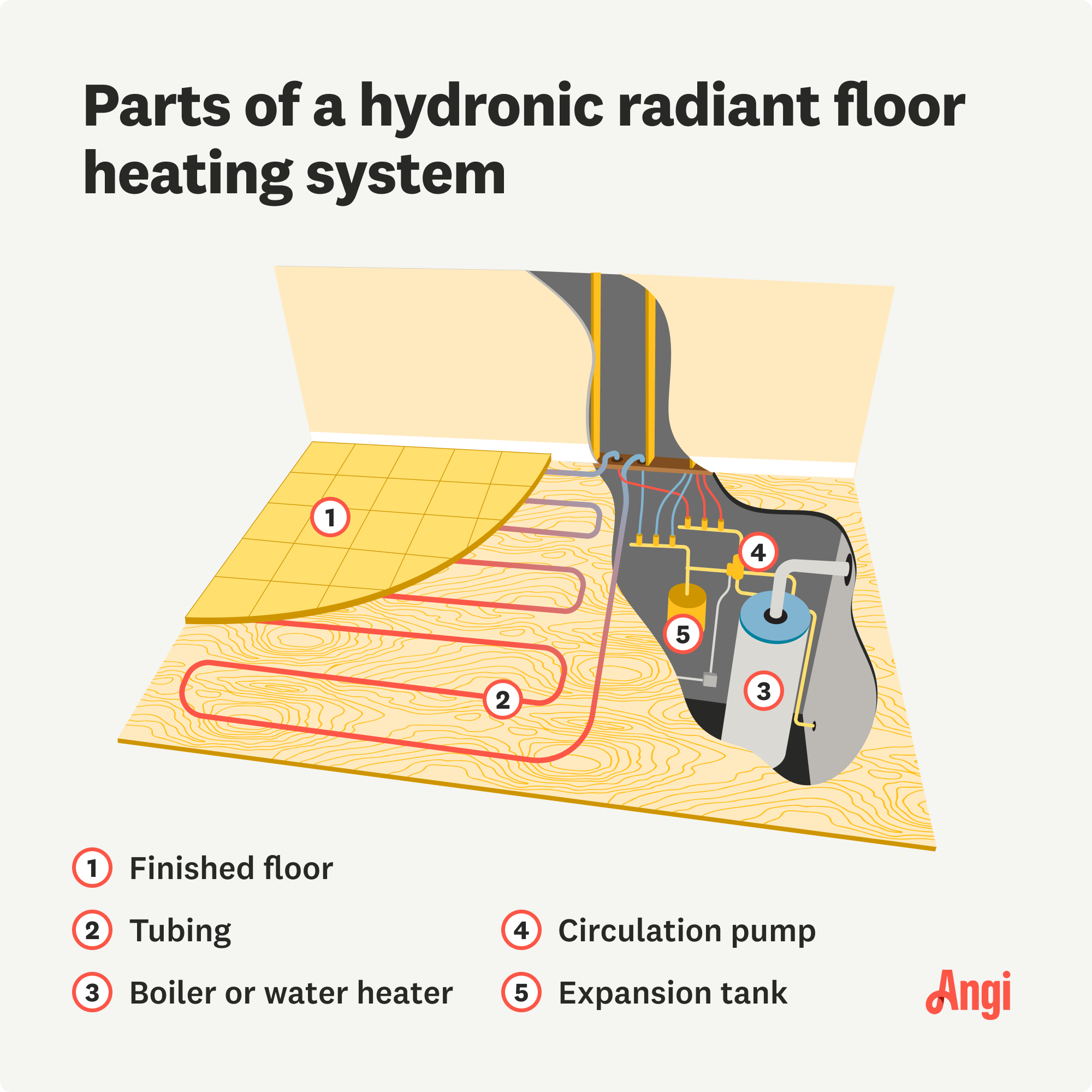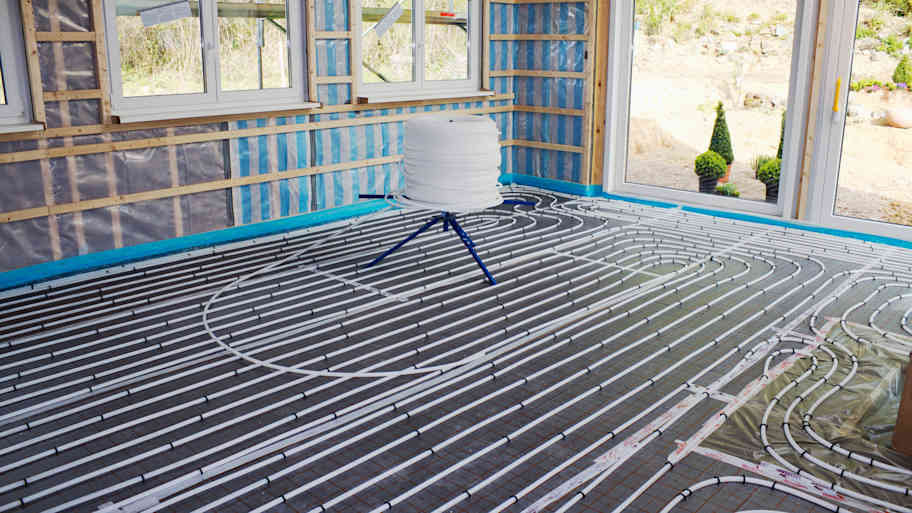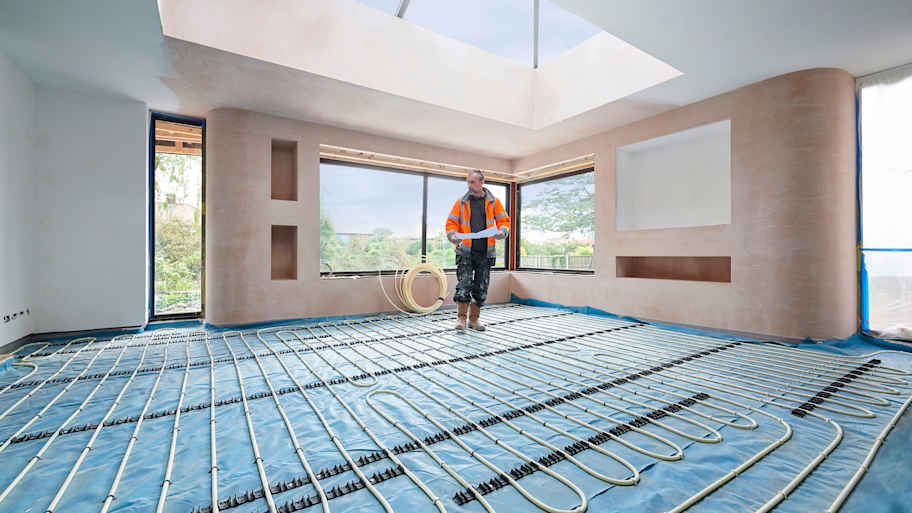
Repairing ductwork in a crawl space is frustrating and difficult, which is reflected in the cost. Learn why limited access results in a premium cost beyond just a simple increase in labor hours.
Don’t get cold feet about this luxury upgrade


Radiant floor heating uses heated coils beneath your floor to warm your room.
These coils are heated with warm water, which requires a boiler or electricity.
The pros of radiant floor heating include energy efficiency, a cozy underfoot feeling, and even heating.
The cons of this heating system include high up-front costs, complex repairs, and long wait times to fully heat up a room.
An HVAC tech can let you know if radiant heat flooring will work well in your home.
When winter comes around, we become all too familiar with the chill when our bare feet hit a cold floor. It can feel like a shock to the system that wakes you up better than your morning coffee—but it’s not necessarily a good thing. Enter: Radiant floor heating, a type of underfloor heating that can make your space a lot more cozy. Your feet will thank you, but understand the pros and cons of radiant floor heating before jumping into this renovation.


Radiant floor heating is a home heating system that rests underneath your flooring. Instead of using traditional heating vents that blow warm air into a room, this system uses hot coils to radiate heat upward. In turn, the heat transfers from the coils to your floor, and you get to say goodbye to cold feet. There are two main types of radiant floor heating:
Hydronic radiant floor heating uses tubes (or coils) filled with hot water to heat your floor.
Electric radiant floor heating uses electricity to heat the coils that heat your floor.
Before you install heated floors, there are a few things to consider. Radiant floor heating is an excellent solution, but it isn’t right for every home. An HVAC pro can assess your home and let you know which system best fits your needs.
| Pros of Radiant Floor Heating | Cons of Radiant Floor Heating |
|---|---|
| Energy efficient and low-maintenance | High up-front cost |
| No more cold feet | Inconvenient installation with preexisting floors |
| Evenly heats the room | Can elevate floor height |
| Allergy-friendly | Slow heat-up time |
| Simple installation in new construction or during a remodel | Repairs require pulling up the flooring |
Some homeowners enjoy radiant floor heating for its benefits when compared to traditional heating systems. Here are some of the pros.
Radiant floor heating can improve your home’s energy efficiency. You can set it to a much lower temperature to receive the same results as traditional heating systems like radiators. Depending on the model, it can operate up to 25% more efficiently than the average outdated heating system, which can help homeowners save up to 20% on their electricity costs.
The biggest benefit of radiant floor heating is that, rather than heating the air around you, it heats the floor first. Your floor will be warm and comfortable underneath your feet without the need for carpet or a rug as a buffer.
Traditional systems like radiators heat the air around them, leading to pockets of warm air and pockets of cool air. It can make your home feel too cold or stuffy, never quite landing on the sweet spot. Radiant floor heating, on the other hand, evenly heats the room because it heats the entire floor, which radiates the heat upward.
Hydronic or electronic radiant floor heating systems are allergy-friendly. Unlike forced air systems, they don’t blow around allergens and don’t use ductwork that collects dust, pet dander, and the like.
It is simple to install radiant floor heating as long as you do so before you install your floor. Some ultra-handy homeowners can install their own hydronic systems, but in most cases, this job should be handled by a local HVAC professional. Once the system is installed, it requires little maintenance, and there’s no ductwork to clean out or filters to change.

Despite the energy efficiency and other benefits, there are some drawbacks to consider. Here are the cons of radiant floor heating.
These kinds of heating systems come with a high up-front cost, even though they will on on electricity in the long run. The average cost to install radiant floor heating is between $1,700 and $6,700, but if you want to install it across a whole 2,300-square-foot home, you could spend upward of $48,000. Hydronic systems are the most expensive, with an average cost range of $19,000 to $48,000.
Radiant floor heating systems can be inconvenient to install if you need to remove a floor, which is why most people choose to upgrade to radiant floor heating when they’re already planning to replace their floors.
Because radiant floor heating takes up space under your floor, it can elevate your floor height by a couple of inches. This can pose a problem for doorways, baseboards, and built-in cabinets and may require extra labor during the installation.
Radiant floors don’t heat a room as quickly as forced air systems or radiators because they gradually heat the floor, which then heats the air. The good news is that once the room is heated, the temperature will remain consistent.
Radiant floor heating doesn’t need repairs often, but when something breaks, you will need to pull up the flooring to fix it. As a result, your repair costs will be higher because you will also have to factor in floor repairs.
In addition to traditional electronic or hydronic floor systems, there are a few different radiant heating systems. You can install these in locations other than your flooring, such as a wall. Talk to an HVAC pro to understand which is best for your home.
Geothermal heat pumps: Geothermal heat pumps are a type of underfloor heating that extracts heat from the ground and circulates it through your room via piping. By reversing the process, they can also cool your floors in the summertime.
Solar floor heating: This eco-friendly option harnesses the sun's energy to warm your home.
Propane-powered systems: If you need to cut down on costs, propane systems are more affordable than electronic systems or hydronic systems, which use natural gas.
Air-heated systems: This type of heating pushes warm air through ducts underneath your flooring to heat your room. They’re less efficient and less common than traditional radiant floor heating systems.
Radiant floor heating is an excellent option for homeowners who want more efficient heating or are tired of being chilly when stepping on a cold floor. It’s particularly popular in rooms with flooring that gets the coldest, like bathroom tile.
That said, consider the installation process before making a decision. A large hydronic system can overpower your boiler, and you may need to install a larger boiler or a radiant heating system with highly conductive panels that won’t put as much stress on your boiler. This can significantly add to the total cost.
Additionally, the perfect time to install radiant floor heating is when you plan to replace your floor, because you’ll have to install a new floor in either case. Certain types of flooring, like concrete, may lead to a more challenging install. If you hire an expert HVAC technician, they can point you in the right direction.
From average costs to expert advice, get all the answers you need to get your job done.

Repairing ductwork in a crawl space is frustrating and difficult, which is reflected in the cost. Learn why limited access results in a premium cost beyond just a simple increase in labor hours.

Exposed ductwork can be a smart choice even beyond aesthetics. Fortunately, exposed ductwork costs are relatively low, and easy access keeps repair costs to a minimum.

Getting AC and furnace replacement done at the same time can lead to huge benefits for your wallet and your home. Here’s everything you need to know.

Not sure who to hire to install radiant floor heating? Learn which pros handle radiant floor heating installation and how the work comes together.

Discover the benefits of a DIY outdoor wood furnace forced-air system. Cut costs, reduce fire risk, and embrace renewable heat for your home.

Learn about the different types of electric furnaces to decide why you would use one and which option is best for replacing your home heating system.